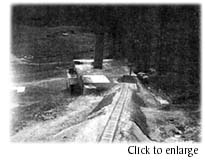| The outer SS area and the prison camp were surrounded
by day by a long chain of sentries, since squads of prisoners were assigned to work in the
SS barracks. From 1941 on, the prison camp with the special camp for Russian prisoners of
war was secured by a double fence, which not only emphasised the unbridgeable separation
between absolute ruler and slave labourers, but also served to fully isolate the prisoners
from the outer world. While the inner fence consisted of thickly interwoven barbed wire,
the smooth upper strands of the outer fence were electrified. The prisoners' area was
secured both day and night by six large watch towers with heavy machine-guns, and hand
grenades in the roofed-over balconies which circled them. In addition, there were 12 small
sentry towers with light machine-guns and also four massive bunkers. |
|


